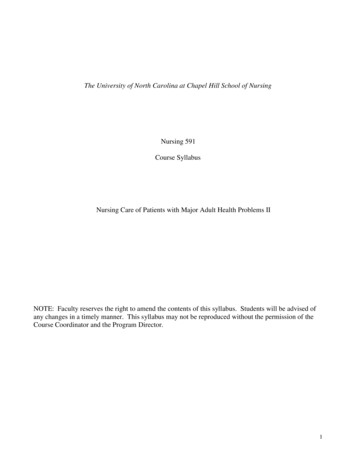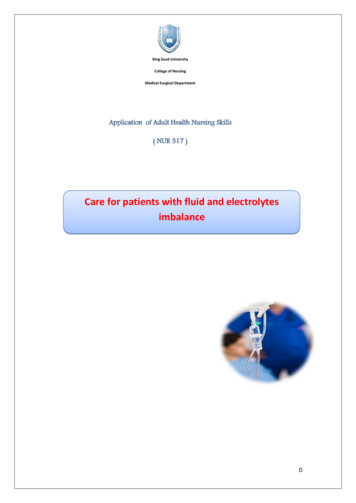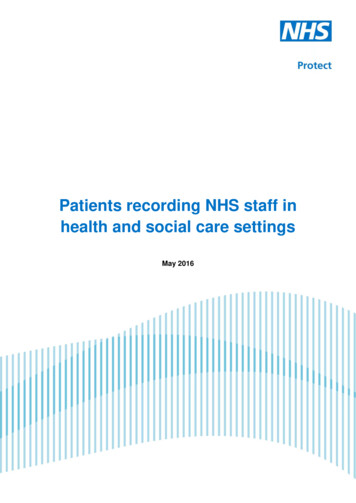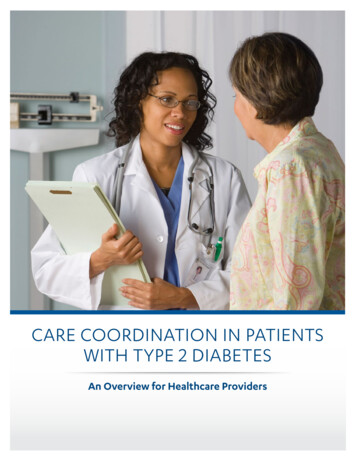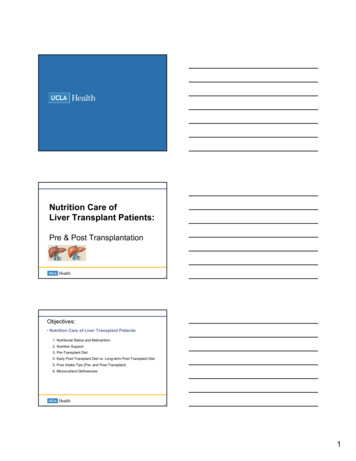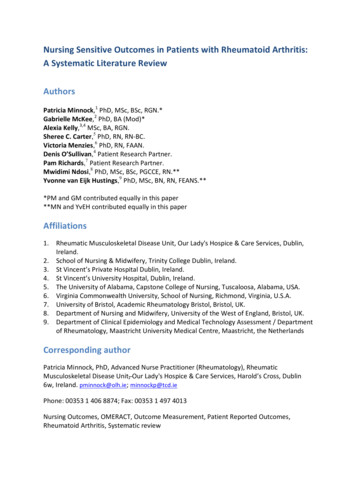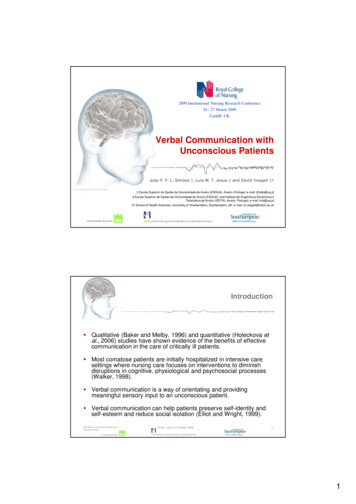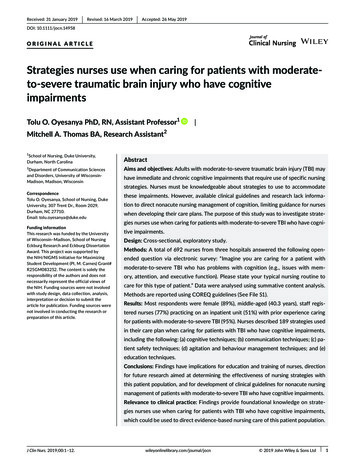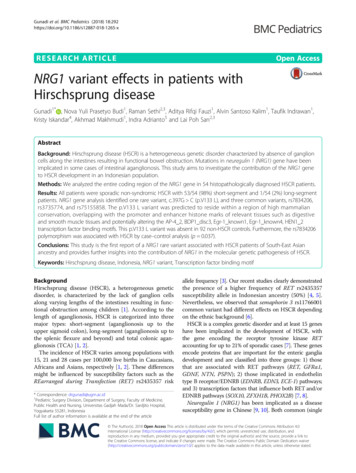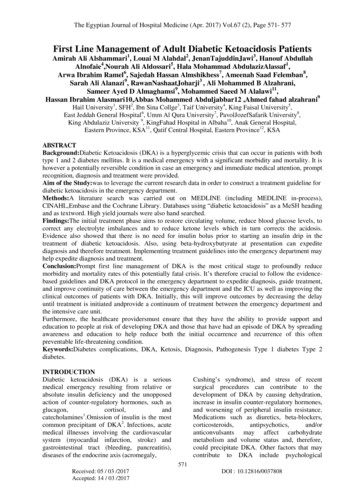
Transcription
31 ursing Care of PatientsNwith Cardiac DisordersLEARNING OUTCOMES1. Compare and contrast the etiology, pathophysiology, andmanifestations of common cardiac disorders, including heartfailure, structural disorders, and inflammatory disorders.2. Explain risk factors and preventive measures for cardiacdisorders such as heart failure, inflammatory disorders, andvalve disorders.3. Discuss indications for and management of patients with hemodynamic monitoring.4. Discuss the effects and nursing implications for medicationscommonly prescribed for patients with cardiac disorders.5. Describe nursing care for the patient undergoing cardiac surgery or cardiac transplant.CLINICAL COMPETENCIES1. Apply knowledge of normal cardiac anatomy and physiologyand assessment techniques in caring for patients with cardiac disorders.2. Assess the functional health status of patients with cardiacdisorders, documenting and reporting deviations for expected findings.3. Based on patient assessment and knowledge of the disorder,determine priority nursing diagnoses.4. Plan, prioritize, and provide evidence-based, individualizedcare for patients with cardiac disorders.5. Safely and knowledgeably administer prescribed medications and treatments to patients with cardiac disorders.6. Actively participate in planning and coordinating interprofessional care for patients with cardiac disorders.7. Provide appropriate teaching and community-based care forpatients with cardiac disorders and their families.8. Evaluate the effectiveness of nursing care, revising the planof care as needed to promote, maintain, or restore the functional health status of patients with cardiac disorders.MAJOR CHAPTER CONCEPTS Heart failure, the most common cardiac disorder, is a condition in which the heart is unable to pump effectively to meetthe body’s needs for blood and oxygen to the tissues. Heart failure is due to impaired myocardial contraction or excessive workload. Goals of heart failure management are to reduce the workload and improve its function. Medical management includesmedication use including ACE inhibitors, beta-blockers, diuretics, and vasodilators to reduce the cardiac workload. Nursing care of the patient with heart failure is primarily supportive and educative, providing the patient and family withthe necessary knowledge and resources to manage thischronic condition.KEY TERMSaortic valve, 950cardiac tamponade, 947cardiomyopathy, 959endocarditis, 941heart failure, 920hemodynamics, 926mean arterial pressure(MAP), 927mitral valve, 950murmur, 951myocarditis, 945orthopnea, 924Cardiac disorders affect the structure and/or function of the heart.These disorders interfere with the heart’s primary purpose: topump enough blood to meet the body’s demand for oxygen andnutrients. Disruptions in cardiac function affect the functioningof other organs and tissues, potentially leading to organ systemparoxysmal nocturnal dyspnea(PND), 924pericarditis, 946pulmonary edema, 935pulmonic valve, 950regurgitation, 939rheumatic fever, 939rheumatic heart disease(RHD), 939stenosis, 939tricuspid valve, 950valvular heart disease, 950failure and death. Emergence of symptoms (fatigue, dyspnea, chestpain) is common with the progression of cardiac disorders. TheNew York Heart Association (NYHA) classification is commonlyused to describe the severity of exertional symptoms observed(see Table 31–1).919
920Unit 8 TABLE 31–1Responses to Altered Cardiovascular FunctionNew York Heart AssociationClassificationClassSeverity of SymptomsINo limitation in physical activity/asymptomaticIISymptoms with strenuous activityIIISymptoms with mild activityIVSymptoms at restHeart failure is the most common cardiac disorder. Othercardiac disorders discussed in this chapter include structural cardiac disorders, such as valve disorders and cardiomyopathy, andinflammatory cardiac disorders, such as endocarditis and pericarditis. B efore continuing with this chapter, please review the heart’sanatomy and physiology, nursing assessment, and diagnostic testsin Chapter 29.Heart FailureHeart failure is a complex syndrome resulting from cardiac disorders that impair the ventricles’ ability to fill with and effectively pumpblood. In heart failure, the heart is unable to pump enough blood tomeet the metabolic demands of the body. It is the end result of manyconditions. Frequently, it is a long-term effect of coronary heart disease and myocardial infarction (MI) when left ventricular damageis extensive enough to impair cardiac output (refer to Chapter 29).Other diseases of the heart also may cause heart failure, includingstructural and inflammatory disorders. In normal hearts, failure canresult from excessive demands placed on the heart. Heart failure maybe acute or chronic.The Patient with Heart FailureAs mentioned, heart failure develops when the heart cannot effectively fill or contract with adequate strength to function as a pump tomeet the needs of the body. As a result, cardiac output falls, leadingto decreased tissue perfusion. The body initially adjusts to reducedcardiac output by activating inherent compensatory mechanismsto restore tissue perfusion. These normal mechanisms may resultin vascular congestion—hence, the commonly used term congestiveheart failure (CHF). As these mechanisms are exhausted, heart failure ensues, with increased morbidity and mortality.Heart failure is a disorder of cardiac function. It frequently is dueto impaired myocardial contraction, which may result from coronaryheart disease and myocardial ischemia or infarct or from a primarycardiac muscle disorder such as cardiomyopathy or myocarditis.Structural cardiac disorders, such as valve disorders or congenitalheart defects, and hypertension also can lead to heart failure when theheart muscle is damaged by the long-standing excessive workload associated with these conditions. Other patients without a primary abnormality of myocardial function may present with manifestations ofheart failure due to acute excess demands placed on the myocardium,such as volume overload, hyperthyroidism, and massive pulmonaryembolus (see Table 31–2). Hypertension and coronary heart diseaseare the leading causes of heart failure in the United States. The highTABLE 31–2Incidence, Prevalence, and Risk FactorsMore than 6.6 million people in the United States are currently livingwith heart failure; approximately 550,000 new cases of heart failureare diagnosed annually (American Heart Association [AHA], 2013).Estimates predict an additional 3 million people will have heart failure by 2030. Its incidence and prevalence increase with age: Fewerthan 5% of people between ages 55 and 64 have heart failure, whereas6% to 10% of people ages 65 to 74 are affected. There is a rapid rise inheart failure prevalence after age 65. Those ages 75 to 84 have a 14.8to 22.3/1000 person (per) years incidence, while those older than85 years have a 32.7 to 41.9/1000 person-years incidence (see Nursing Care of the Older Adult box). At age 40, the lifetime risk of developing heart failure is one in five (AHA, 2013). The estimated directand indirect cost of heart failure in the United States in 2011 was 34.4 billion. The prevalence and mortality rate for heart failure ishigher in African Americans than in Whites. See the accompanyingFocus on Cultural Diversity box.Ischemic heart disease (coronary heart disease) is the leadingrisk factor for heart failure. Up to 75% of individuals with heart failurehave a history of hypertension.The prognosis for a patient with heart failure depends on its underlying cause and how effectively precipitating factors can be treated.Most patients with heart failure die within 8 years of the diagnosis. Therisk for sudden cardiac death is dramatically increased, occurring at arate six to nine times that of the general population. In 2009, one innine death certificates in the United States mentioned heart failure asthe primary or a contributing cause of death (AHA, 2013).Physiology ReviewThe mechanical pumping action of cardiac muscle propels the bloodit receives to the pulmonary and systemic vascular systems for reoxygenation and delivery to the tissues. Cardiac output (CO) is the amountSelected Causes of Heart FailureImpaired Myocardial Function prevalence of hypertension in African Americans contributes significantly to their risk for and incidence of heart failure.Coronary heart diseaseCardiomyopathiesRheumatic feverInfective endocarditisIncreased Cardiac Workload HypertensionValve disordersAnemiasCongenital heart defectsAcute Noncardiac Conditions Volume overloadHyperthyroidismFever, infectionMassive pulmonary embolus
Chapter 31FOCUS ON CULTURAL DIVERSITYHeart DiseaseUp to 6.6 million Americans have heart failure. Of these, about800,000 (15%) are African Americans. In African Americans: Manifestations of heart failure develop at an earlier age. The disease progresses more rapidly. More hospital visits are attributed to heart failure. The mortality rate is higher than in White men and women. of blood pumped from the ventricles in 1 minute. Cardiac output isused to assess cardiac performance, especially left ventricular function. Effective cardiac output depends on adequate functional musclemass and the ability of the ventricles to work together. Cardiac outputnormally is regulated by the oxygen needs of the body: As oxygen useincreases, cardiac output increases to maintain cellular function. Cardiac reserve is the ability of the heart to increase CO to meet metabolicdemand. Ventricular damage reduces the c ardiac reserve.Cardiac output is a product of heart rate and stroke volume.Heart rate affects cardiac output by controlling the number of ventricular contractions per minute. It is influenced by the autonomicnervous system, catecholamines, and thyroid hormones. Activationof a stress response (e.g., hypovolemia or fear) stimulates the sympathetic nervous system, increasing the heart rate and its contractility. Elevated heart rates increase cardiac output. Very rapid heartrates, however, shorten ventricular filling time (diastole), reducingstroke volume and cardiac output. On the other hand, a slow heartrate r educes cardiac output simply because of fewer cardiac cycles.Stroke volume, the volume of blood ejected with each heartbeat,is determined by preload, afterload, and myocardial contractility. Preload is the volume of blood in the ventricles at end-diastole (justprior to contraction). The blood in the ventricles exerts pressure onthe ventricle walls, stretching muscle fibers. The greater the bloodvolume, the greater the force with which the ventricle contracts to expel the blood. End diastolic volume (EDV) depends on the amount Nursing Care of Patients with Cardiac Disorders 921BOX 31–1Explaining Physiologic TermsUsing Practical ExamplesThe concepts of preload, the Frank-Starling mechanism, compliance, and afterload can be difficult to understand and to explain topatients. Use common analogies to make these concepts easierto understand: Preload: Think about a new rubber band. As you stretch therubber band and then release it, it snaps back into shape withgreat force. Frank-Starling mechanism: When you repeatedly stretch thatrubber band beyond a certain limit, it loses some elasticityand fails to return to its original shape and size. Compliance: Use a new rubber balloon to illustrate thisconcept. A new balloon is not very compliant—it takes alot of work (force) to inflate it. As the balloon is repeatedlystretched, it becomes more compliant, expanding easily withless force. Afterload: When a hose is crimped or plugged, more forceis required to eject a stream of water out its end.of blood returning to the ventricles (venous return), and the distensibility or stiffness of the ventricles (compliance). (See Box 31–1.)Afterload is the force needed to eject blood into the circulation. This force must be great enough to overcome arterial pressureswithin the pulmonary and systemic vascular systems. The right ventricle must generate enough force to open the pulmonary valve andeject its blood into the pulmonary artery. The left ventricle ejects itsblood into the systemic circulation by overcoming the arterial resistance behind the aortic valve. Increased systemic vascular resistance(e.g., hypertension) increases afterload, impairing stroke volume andincreasing myocardial work.Contractility is the natural ability of cardiac muscle fibers toshorten during systole. Contractility is necessary to overcome arterial pressures and eject blood during systole. Impaired contractilityaffects cardiac output by reducing stroke volume. The ejection fraction(EF) is the percentage of blood in the ventricle that is ejected duringsystole. A normal ejection fraction is approximately 60%.NURSING CARE OF THE OLDER ADULTHeart FailureHeart failure is common in older adults, affecting nearly 10% of people over the age of 75 years.Aging affects cardiac function. Diastolic filling is impaired bydecreased ventricular compliance. With aging, the heart is less responsive to SNS stimulation. As a result, maximal heart rate, cardiac reserve, and exercise tolerance are reduced. Concurrent healthproblems such as arthritis that affect stamina or mobility often contribute to a more sedentary lifestyle, further decreasing the heart’sability to respond to increased stress.Assessing for Home CareThe older adult with heart failure may not be dyspneic, instead presenting with weakness and fatigue, somnolence, confusion, disorientation, or worsening dementia. Dependent edema and respiratorycrackles may or may not indicate heart failure in older adults.Assess the diet of the older adult. Decreased taste may lead toincreased use of salt to bring out food flavors. Limited mobility orvisual acuity may cause the older adult to rely on prepared foodsthat are high in sodium such as canned soups and frozen meals.Discuss normal daily activities and assess sleep and rest patterns. Itis also impor
care for patients with cardiac disorders. 5.Safely and knowledgeably administer prescribed medica-tions and treatments to patients with cardiac disorders. 6.Actively participate in planning and coordinating interprofes-sional care for patients with cardiac disorders.
